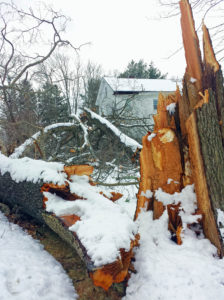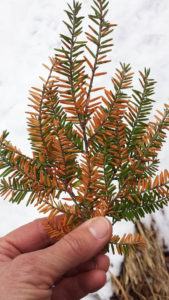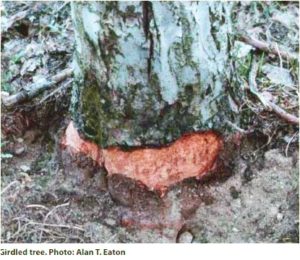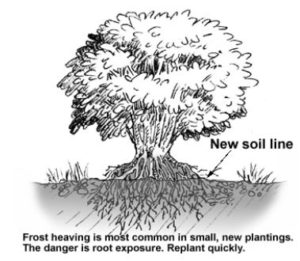
Two massive red oak trees snapped at their bases due to their condition and the forces of winter weather in a front yard in Milton, MA.
THE WEATHA’S BEEN WICKED! Two nor’easters roared through a couple of Marches ago, with another on the way. At the same time, many bulbs were pushing up, and tree and shrub buds were swelling, some already blooming wicked early in the season.
This can be a challenging time of year for your plantings, with the sun intensity increasing, air temperatures and weather fluctuating wildly, and the soil thawing in fits and starts. Plants need time to acclimate to changes in the seasons, and rapid weather changes can cause stress and damage.
4 FOCUS POINTS FOR YOUR WINTER DAMAGE ASSESSMENT
1. Storm damage and breakage
Breakage of trees and shrubs is common in winter storms. The combination of winds, heavy snows and ice bring down many a tree and limb. If you’re at all hesitant to remove damage yourself, stay on the safe side and call in an arborist. If any part of your tree or limb or shrub is within ten feet of a power line, it is not safe for you to do it yourself, unless you yourself are an arborist. Even then, take extreme caution.
2. Winter burn

Your landscape’s winter damage assessment should include inspection of trees and shrubs for winter burn. Here, branches from a Sharon, MA hemlock tree show winter burn damage.
A client in Sharon, MA has two rows of hemlocks on her property, all sourced from the same of nursery at the same time, and poorly planted (with the root balls way too high) at the same time by a gentleman who didn’t know better. Both rows get similar sun and are planted in similar soil. One row grows robustly and needs frequent pruning, the other row shows slow growth and sickly yellow and brown needles. What’s the difference?
One row is at the bottom of a slope, the other along the top of a ridge. The ridge-top hemlocks did not receive enough water their first two years in the ground to get them well established with new roots. They then suffered through a couple of seasons of drought. The difference is WATER.
They needed more water to get established, and they weren’t established so they really suffered in the late fall wind storm. As winter came on, they were stressed and less able to acclimate to the changing season. At the same time the sun had them photosynthesizing, but the ground was frozen solid and little water was available to replenish was was lost through their needles. The result was winter burn on lots of branches. We’ll give them some time and see how they respond as the spring comes along. I expect some of the trees will be replaced.
The good news is that the client invested in irrigation two seasons ago. As long as the watering schedule is appropriate, many trees have the best chance to recover, and any replacement trees, properly planted and with 2-3 inches of mulch, may thrive. Next fall, plan on watering your trees and shrubs all the way until the ground freezes for good.
3. Damage from animals like deer and rabbits

Vole damage on the bark of trees can cause extreme damage and allow insects and other pests and pathogens to enter and further harm the tree.
Got hungry deer in your neighborhood? They’ll taste just about every plant in your yard, and if they like it, they’ll keep eating and keep coming back. In my yard they especially like the evergreen azaleas, including this spring’s flower buds. If you’re ready to do something about it, learn more about deer solutions.
Meadow voles love to make one inch diameter tunnels between the soil and snow, and their network is revealed when the snow melts. They’ll also burrow under any leaf piles and your mulch, where they tunnel to the base of your trees and shrubs and eat the bark off, damaging your plants’ ability to thrive, and opening doors to other pests, insects and pathogens.Then there are the pine voles, which live mostly underground and eat your roots, and live right next door to moles, who eat grubs. Moles and voles resemble mice, who may also like to eat your plants. A good solution to keep voles from damaging your trees is a physical barrier like cylinder of 1/4 inch galvanized hardware cloth.
4. Frost heaving

Winter damage to the landscape include frost heaving, which pushes small shrubs and perennials up out of the soil.
Frost heaving occurs when alternating freeze and thaw cycles push shallow rooted plants out of the ground, especially newly planted ones. This prevents the root system from having good contact with the soil, which prevents uptake of water and nutrients, and exposes the roots to drying winds. As soon as the soil is workable, dig up, replant and apply mulch to act as insulation from additional freeze/thaw cycles and conserve moisture.
